Guitar World Verdict
The G20 is practical and packed with gain. With the onboard Two Notes tech, it's a phenomenal recording tool, but its compact format means it's one for the road, too.
Pros
- +
Great overdrive sounds.
- +
Huge choice of world-class cab sims.
- +
Compact and very portable with a smart carry case included.
Cons
- -
An occasional slight pop on this sample when switching from overdrive to clean sounds.
You can trust Guitar World
Founded in 2014 by Dan Trudeau and Derek Eastveld and based in Winnipeg, Canada, Revv Amplification is the go-to backline for artists as diverse as metal god Jeff Loomis and Nashville session star Jeff King, along with many of Canada’s best-known rock guitarists.
Like most amp manufacturers, Revv saw the potential of a compact ‘lunchbox’ product but wanted to take things to a new level. Its D20 head certainly achieved that, being the world’s first amplifier to integrate the award-winning Two Notes Torpedo reactive load and cabinet emulation technology.
Now, Revv has shifted its lunchbox offering up a gear with the G20 lunchbox head, which features its flagship Generator amp’s high-gain ‘Purple’ channel and increased tonal flexibility.
The Aggression control means the G20 has more than enough tonal range to cope with any gig
Like its stablemate D20, the G20 is compact and portable thanks in part to an accurately cut and folded aluminium chassis, which helps offset the weight of two substantial transformers.
It’s an understated yet smart design finished in polished black enamel, with conventional control knobs on a black fascia and illuminated push-button switches.
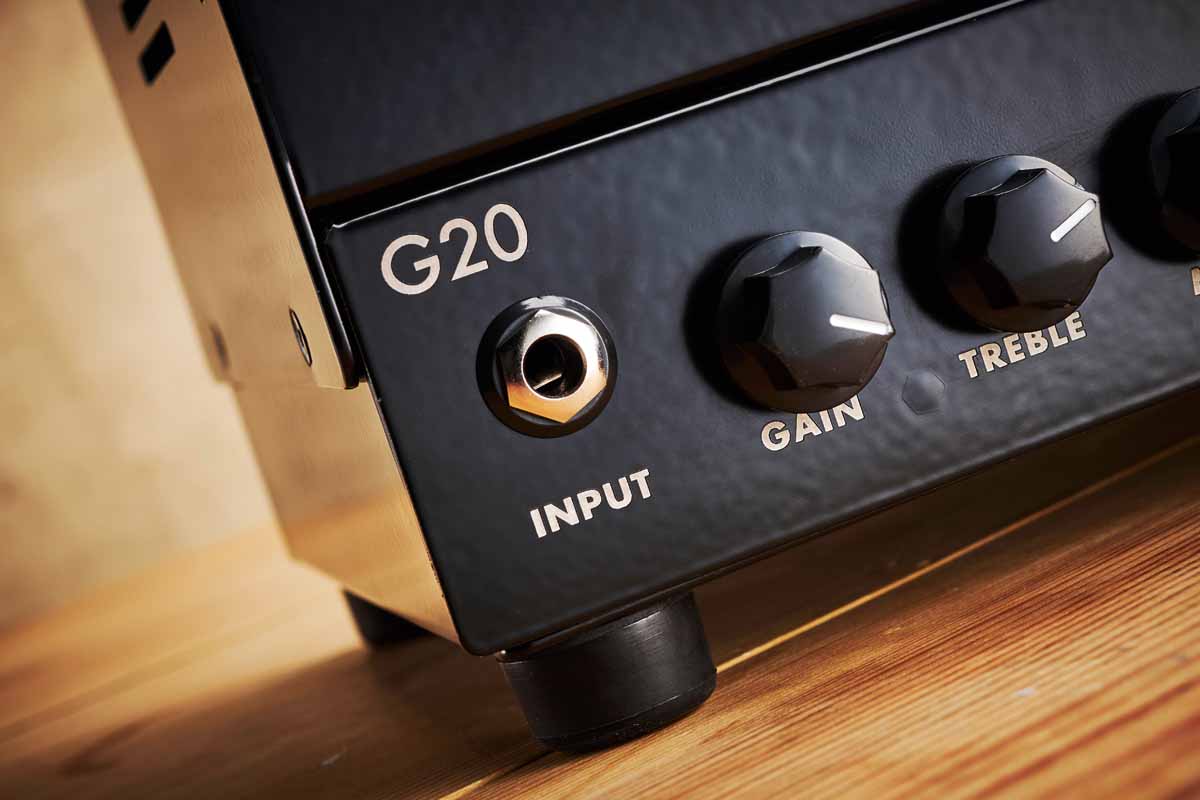
There’s a hefty chrome carry handle that can be folded down as needed. The front of the G20’s cover is dominated by a large ‘Revv’ logo that lights up when the amp is switched on and changes colour depending on which channel is selected. Inside the chassis, the G20’s electronics are densely packed on several high-quality PCBs.
The main board includes sockets for a pair of 12AX7 preamp valves and two 6V6 output valves, as well as supporting daughter boards for the Two Notes module and MIDI switching, with three more for the front and rear panel components. Wiring is minimal and neatly routed; most circuit board connections via plug-in Molex pin connectors.
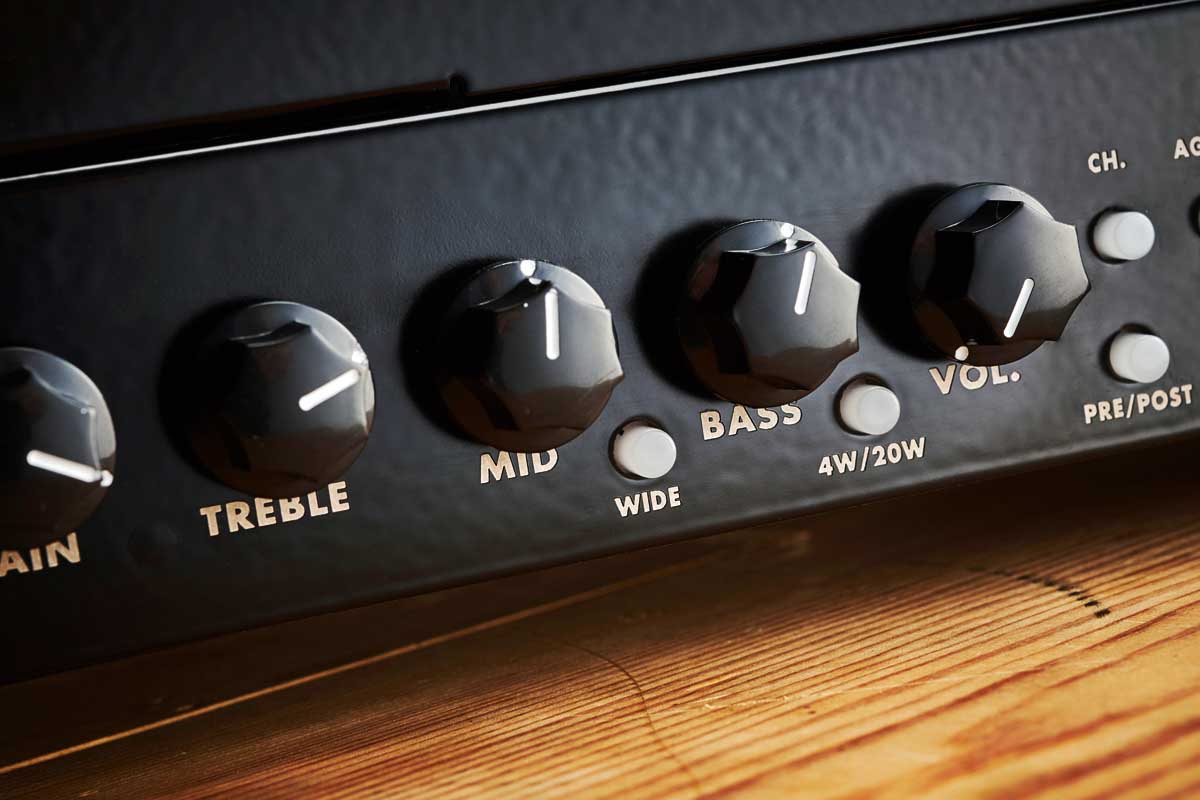
The G20’s onboard controls are fairly straightforward but merit a swift scan through the manual before plugging in and letting rip. Conventional knobs for gain, volume, bass, mid and treble are joined by a six-way rotary switch that accesses a choice of pre-loaded Two Notes cabinet emulations.
A push-button switch between the mid and bass knobs activates a tone mode called Wide, with another switch between the bass and master volume controls operating a built-in attenuator that drops the G20’s output from 20 watts down to around four watts.
Overall, the G20 gives off a solid, no-nonsense vibe, designed and built to a high standard for many years of trouble-free use
There are more push-button switches for changing channels, operating the G20’s three-way Aggression mode and saving patch settings.
A fourth switch called Pre/Post switches the G20’s Direct and headphones outputs before or after its 6V6 valve power stage, allowing use of the Two Notes virtual power amp feature instead, with a choice of virtual power stages including 6L6s, EL84s and EL34s.
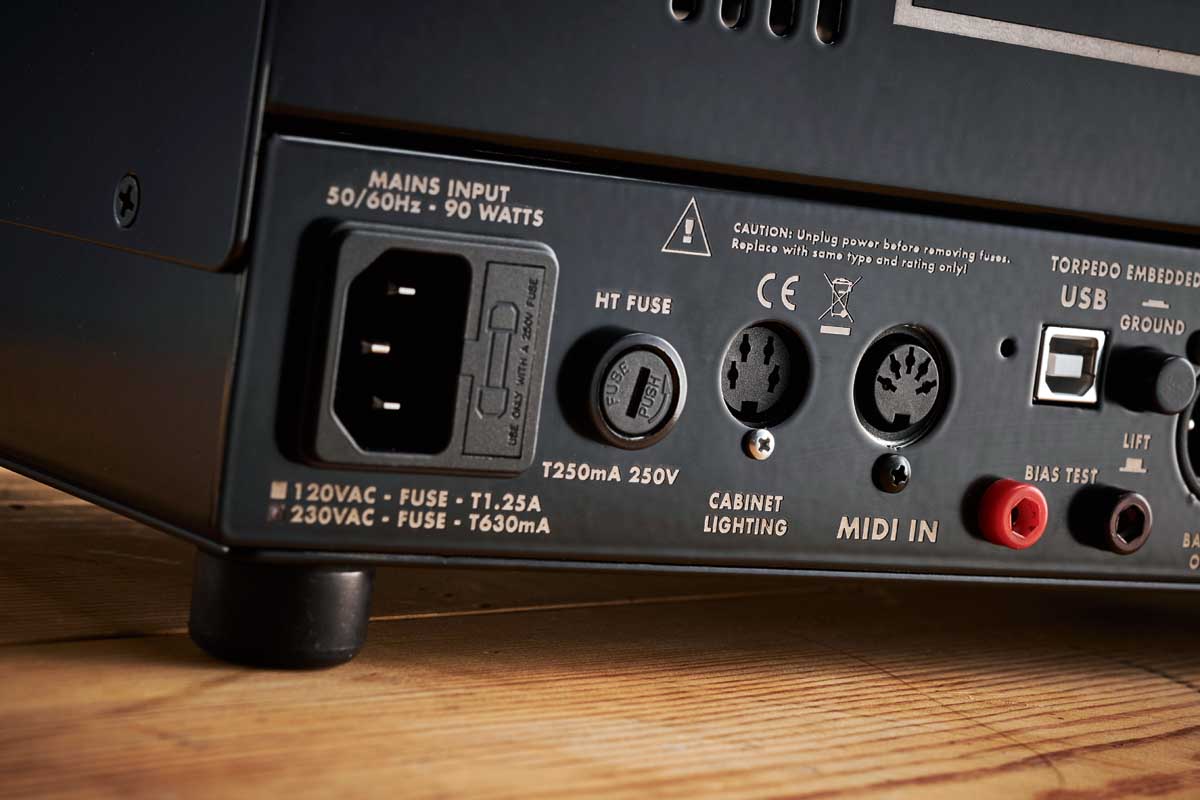
There’s a headphone jack on the front panel with its own level control and a clip LED. The rear panel’s offerings includes MIDI in, with a four-pin DIN socket that’s used to power the illuminated logo in some of Revv’s own speaker cabinets.
There’s a USB socket for hooking up the G20 to the Two Notes Torpedo Remote app, while direct-to-desk connection is handled by a balanced XLR jack with a ground lift.
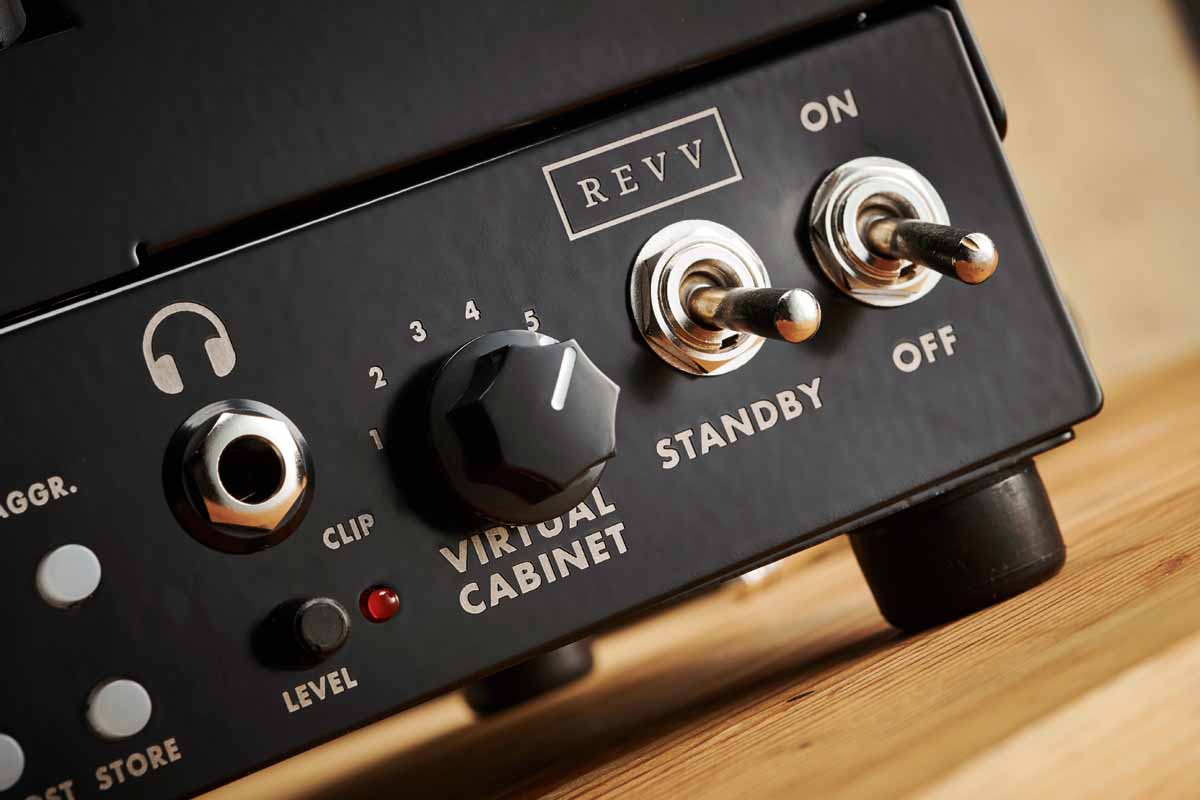
Other features include a buffered series effects loop and a single speaker jack, with impedance and defeat switches. A pair of test points lets you check the output valve bias current, and the adjuster is sensibly out of harm’s way on the top of the chassis.
There’s also a socket for the G20’s dedicated footswitch, but most users will want to make full use of the G20’s MIDI functionality and integrate it into a wider MIDI-enabled rig.
Overall, the G20 gives off a solid, no-nonsense vibe, designed and built to a high standard for many years of trouble-free use.
Feel & Sounds
The Revv G20 fires up with minimal hiss and hum, which is usually a sign of a well-sorted circuit. Plugged into a Vintage 30-loaded 2x12 open-back cabinet, the G20’s Fender-influenced clean sound is smooth and warm, with enough range on the controls to add extra sparkle for humbuckers or emphasise a little more midrange for single coils.
The Wide function helps at lower volume levels by adding extra bass and treble to the clean channel, or more of a low-end push to the lead channel, making the G20 sound louder and bigger
Switching to the lead channel activates the gain control and unleashes the Revv’s signature solo tone, rich in harmonics with a sweet Californian-inspired top-end
Switching to the lead channel activates the gain control and unleashes the Revv’s signature solo tone, rich in harmonics with a sweet Californian-inspired top-end that can be made to squeal or snarl on demand, using the three-stage Aggression switch, which changes colour to indicate which mode is active.
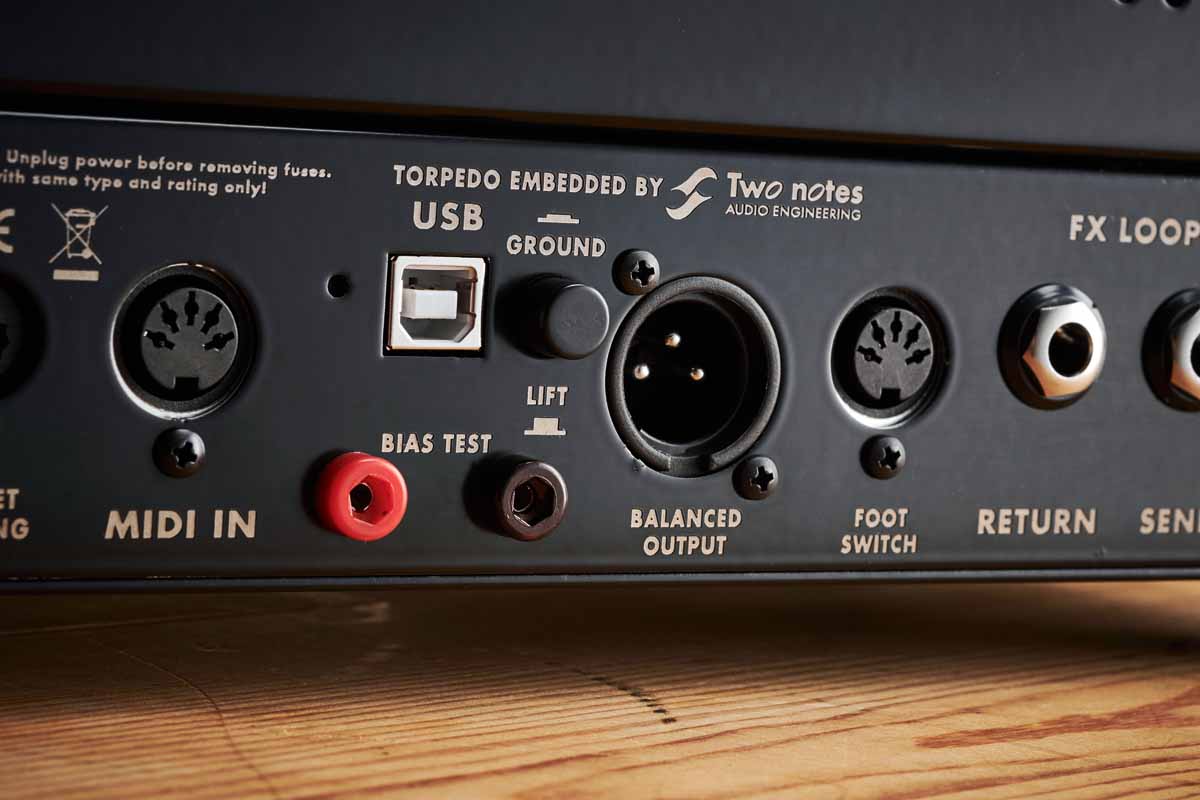
The embedded Two Notes reactive load and cabinet emulation module offers six pre-loaded cabinets accessed from the six-way switch on the front panel. You’ll need to load the Torpedo Remote app on your desktop and connect the G20 using a standard USB printer lead, which couldn’t be easier to do.
On our Windows 10 desktop it took just a few seconds to install the app, while the G20 was immediately recognised as a USB device. From within the Torpedo Remote app, you can decide on your virtual room ambience, choose your virtual cabinet, add virtual microphones, load IRs and edit dozens of parameters to your heart’s content.
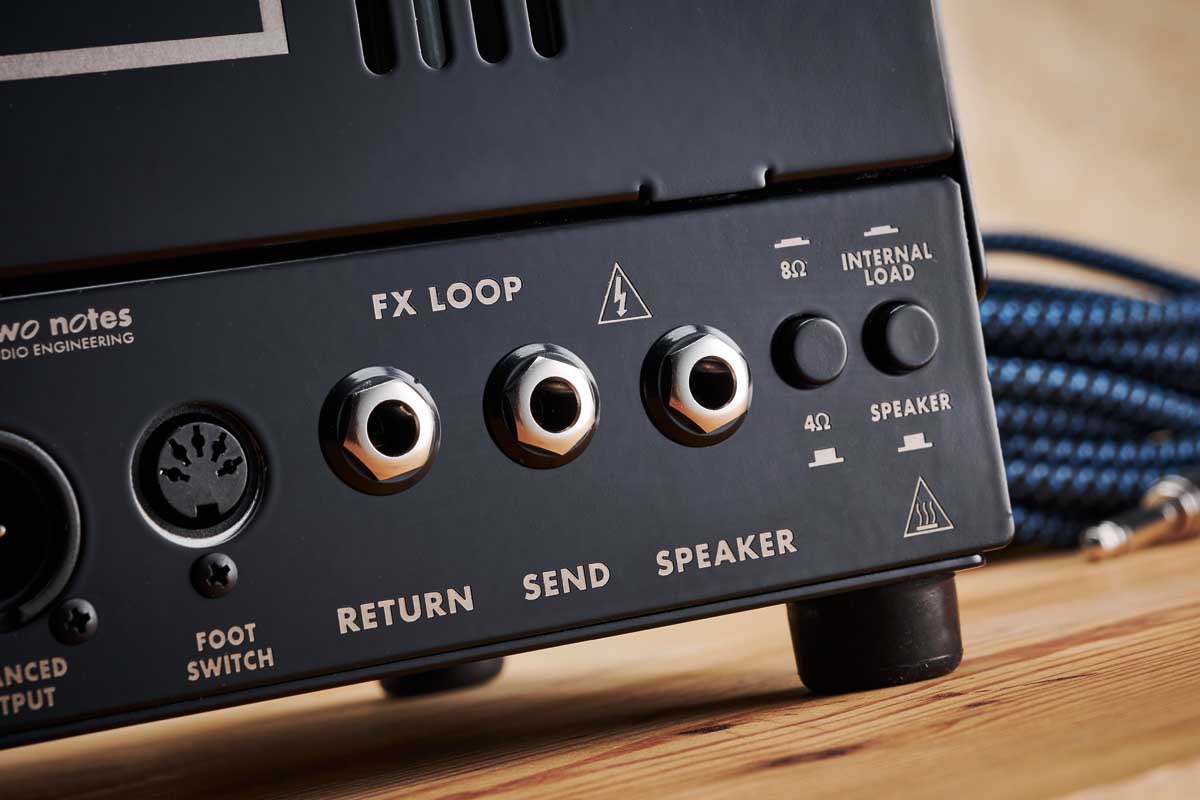
The Two Notes digital effects are added to the XLR and headphones outputs but don’t come down the speaker lead, making the G20 ideal for the wet/dry mix setups favoured by many pro players.
The Pre/Post switch is a very cool feature, letting you bypass the G20’s real 6V6 output stage for direct and headphones signal paths and substitute the Two Notes virtual power amp, so you can experiment with other valve emulations, each with a distinctively different character.
The addition of the Two Notes embedded technology is what catapults the G20 into a league of its own
With all the G20’s switched functions accessible by MIDI and up to 128 Torpedo patches to store things in, there’s no end to the variety of tones you can create.
The Two Notes emulations are impressively realistic, while the Torpedo Remote graphics are beautifully realised, making this feature a real delight to use.
The G20’s 20-watt full output provides plenty of punch for small to medium gigs while the four-watt setting is perfect for studio use, allowing the amp to be cranked up at more sensible decibel levels.
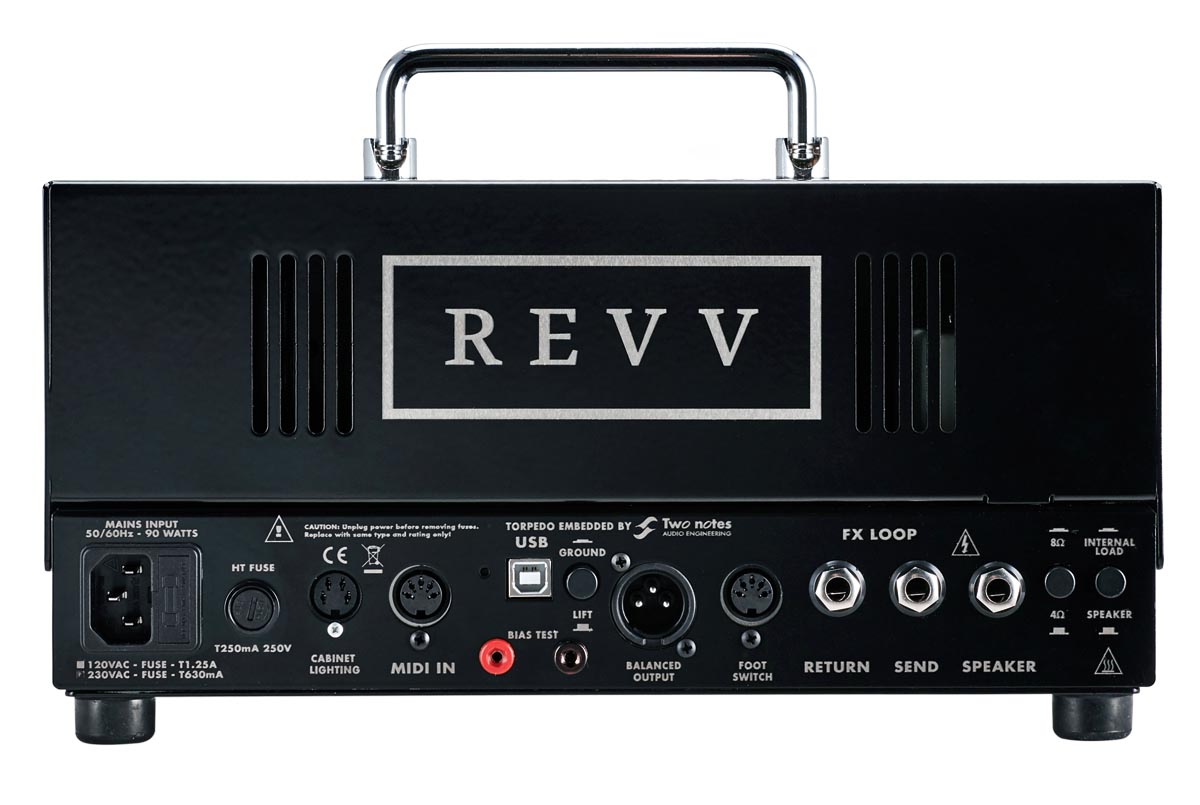
Verdict
Revv has done a great job on the G20. It’s compact, portable and built to last. The aluminium chassis is an extra touch of class, offering improved screening, no interaction with transformers, better heat dissipation and, of course, lighter weight compared with its steel-clad competitors.
Thanks to the three-stage Aggression control the G20 has more than enough tonal range to cope with any gig from jazz to metal, while MIDI makes it easy to store and recall patches.
Aimed at serious live and studio players at all levels, we reckon it’s excellent value for money
The addition of the Two Notes embedded technology is what catapults the G20 into a league of its own, though, with worldclass cabinet simulations, EQ, reverb and lots more. The G20’s practically seamless integration between old tech valves, MIDI control and the Two Notes digital plug-in, make it a pleasure to use.
Aimed at serious live and studio players at all levels, we reckon it’s excellent value for money and could be the perfect tool for those who want the reassuring security of a real amp, while enjoying the versatility of cutting-edge direct-to-desk cab simulation. Revv’s G20 is proof that sometimes you can have your cake and eat it.
Specs
- PRICE: $1,299 / £1,135
- ORIGIN: Canada
- TYPE: Valve preamp and power amp with Two Notes Torpedo reactive load and cabinet emulation
- OUTPUT: 20W switchable to 4W
- VALVES: 2x 12AX7, 2x 6V6
- DIMENSIONS: 190 (h) x 160 (d) x 315mm (w)
- WEIGHT(kg/lb): 4/9
- CABINET: Aluminium
- CHANNELS: 2 with a choice of 6 internal cabinet emulations from the built-in Torpedo module
- CONTROLS: Gain, treble, mid, bass, volume, 6-way virtual cabinet select. Wide switch, Aggression switch, 4/20-watt output switch, channel switch, store switch
- FOOTSWITCH: Not supplied, can also be controlled via MIDI
- ADDITIONAL FEATURES: Built-in Two Notes Torpedo reactive load/cab sim, USB (connects to Torpedo Remote app), balanced XLR recording out with ground lift, buffered series effects loop, external bias test points, pre/post switch removes power amp from direct output signal chain, headphones output with level control, MIDI in, cabinet lighting extension socket for dedicated Revv enclosures
- OPTIONS: A dedicated footswitch will be available soon, but the MIDI option allows superior control and patch recall. There are matching cabs (UK availability TBA)
- RANGE OPTIONS: The D20 is a little simpler and costs $1,199 / £1,049
- CONTACT: Revv Amplification
Nick Guppy was Guitarist magazine's amp guru for over 20 years. He built his first valve amplifier at the age of 12 and bought, sold and restored many more, with a particular interest in Vox, Selmer, Orange and tweed-era Fenders, alongside Riveras and Mark Series Boogies. When wielding a guitar instead of soldering iron, he enjoyed a diverse musical career playing all over the UK, including occasional stints with theatre groups, orchestras and big bands as well as power trios and tributes. He passed away suddenly in April 2024, leaving a legacy of amplifier wisdom behind him.
"I never use my tube amp at home now, because I have a Spark Live": 5 reasons you should be picking up the Positive Grid Spark Live in the massive Guitar Month sale
“Our goal is to stay at the forefront of amplification innovation”: How Seymour Duncan set out to create the ultimate bass amp solution by pushing its PowerStage lineup to greater heights












